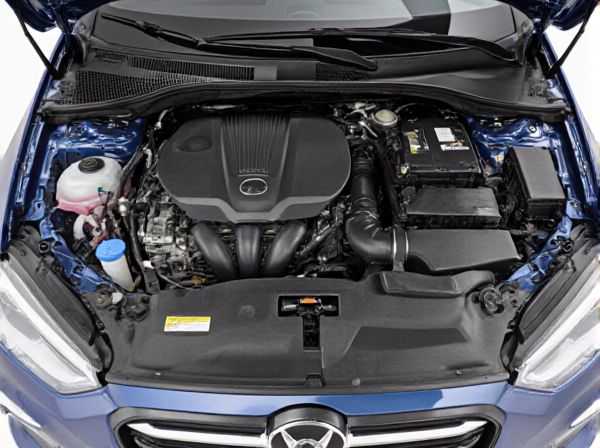
Photo illustration: Wet Liner vs Dry Liner
Wet liners are cylinders that remain in contact with engine coolant, providing superior heat dissipation and better sealing, which enhances engine durability. Dry liners fit directly into the engine block without coolant contact, allowing easier replacement and repair but may sacrifice some cooling efficiency. Your choice between wet and dry liners depends on engine design priorities such as maintenance ease and thermal management requirements.
Table of Comparison
| Feature | Wet Liner | Dry Liner |
|---|---|---|
| Definition | Replaceable cylinder liner in direct contact with engine coolant | Fixed cylinder liner isolated from engine coolant |
| Cooling Efficiency | High - coolant flows around the liner | Lower - coolant flow limited to block walls |
| Replacement | Easy - removable and replaceable | Difficult - integral with engine block |
| Seal Type | Requires sealing rings to prevent coolant leakage | Sealed by block; no direct coolant contact |
| Engine Weight | Generally heavier due to liner design | Typically lighter engine construction |
| Common Applications | Heavy-duty diesel engines, industrial engines | Passenger cars, light-duty engines |
| Durability | Good - easy liner replacement extends engine life | Good - but requires block machining for liner issues |
Introduction to Engine Liners
Engine liners are critical components in internal combustion engines, serving as the wear-resistant surface within the cylinder bore where piston movement occurs. Wet liners are designed with a direct contact interface with the engine coolant, enhancing heat dissipation and simplifying replacement, while dry liners fit into the cylinder block without coolant contact, offering a more rigid structural integration. The choice between wet and dry liners impacts engine cooling efficiency, durability, and maintenance procedures, influencing overall engine performance and longevity.
What is a Wet Liner?
A wet liner is a type of engine cylinder liner that is directly exposed to the engine coolant, allowing efficient heat transfer and improved cooling performance. It is typically made from materials with high thermal conductivity such as cast iron or steel, and features an outer surface in direct contact with coolant, which helps prevent overheating and extends engine life. Wet liners are commonly used in heavy-duty engines and diesel applications due to their enhanced thermal management and ease of replacement.
What is a Dry Liner?
A dry liner is a cylinder liner design that fits tightly inside the engine block without direct contact with the coolant, relying on an interference fit to maintain sealing and heat transfer. Unlike wet liners, dry liners are surrounded by the engine block material, providing structural support and preventing coolant from entering the combustion chamber area. This design enhances engine durability and simplifies maintenance while offering efficient heat dissipation through the block.
Key Differences Between Wet and Dry Liners
Wet liners are directly in contact with the engine coolant, allowing efficient heat transfer and improved cooling, while dry liners are insulated from the coolant by the engine block material. Wet liners can be replaced individually without machining the block, enhancing maintenance flexibility, whereas dry liners require precise engine block machining and are typically integrated into the cylinder block. The choice between wet and dry liners significantly affects engine cooling efficiency, repairability, and overall durability in automotive applications.
Advantages of Wet Liners
Wet liners offer superior cooling efficiency by allowing coolant to flow directly around the cylinder walls, reducing engine heat and enhancing performance. They provide easier replacement and maintenance without the need to remove the entire engine block, lowering repair costs and downtime. Wet liners also improve engine durability by minimizing warping and corrosion, resulting in longer engine life compared to dry liners.
Advantages of Dry Liners
Dry liners offer superior installation speed and ease of maintenance compared to wet liners, reducing downtime and labor costs significantly. Their waterproof and durable construction minimizes the risk of leakage and corrosion, enhancing engine reliability and longevity. Dry liners also provide better heat dissipation, improving overall thermal efficiency and engine performance.
Applications and Suitability
Wet liners are ideal for heavy-duty marine engines and large diesel applications due to their superior cooling efficiency and ability to withstand high thermal stresses. Dry liners suit automotive and small engine uses where lighter weight and easier maintenance are critical, offering simplified installation without a coolant contact surface. Selecting between wet and dry liners depends on operational environment demands, cooling requirements, and engine design constraints.
Maintenance and Replacement Considerations
Wet liners, which are directly exposed to coolant, often require more frequent maintenance due to potential corrosion and gasket wear, demanding regular inspection and timely replacement to prevent engine damage. Dry liners, being isolated from the coolant, tend to have a longer lifespan and simpler replacement procedures, as they are press-fitted into the engine block and can be removed without dismantling the entire cooling system. Choosing between wet and dry liners hinges on balancing maintenance complexity and replacement ease with the specific engine design and operational demands.
Common Issues and Solutions
Wet liners often face common issues such as corrosion and coolant leakage, which can cause engine overheating and reduced efficiency. Solutions include using corrosion-resistant materials like cast iron or applying protective coatings, along with ensuring proper gasket sealing to prevent leaks. Dry liners may suffer from poor heat dissipation and liner movement, solvable by precise machining for a tight fit and utilizing thermal barrier coatings to enhance durability.
Choosing the Right Liner for Your Engine
Choosing the right engine liner depends on factors such as engine design, performance requirements, and maintenance preferences. Wet liners provide better cooling as they are in direct contact with the coolant, making them ideal for high-performance or heavy-duty engines. Dry liners, being easier to replace and more cost-effective, suit lighter engines or applications where durability and quick maintenance are prioritized.
 caratoz.com
caratoz.com